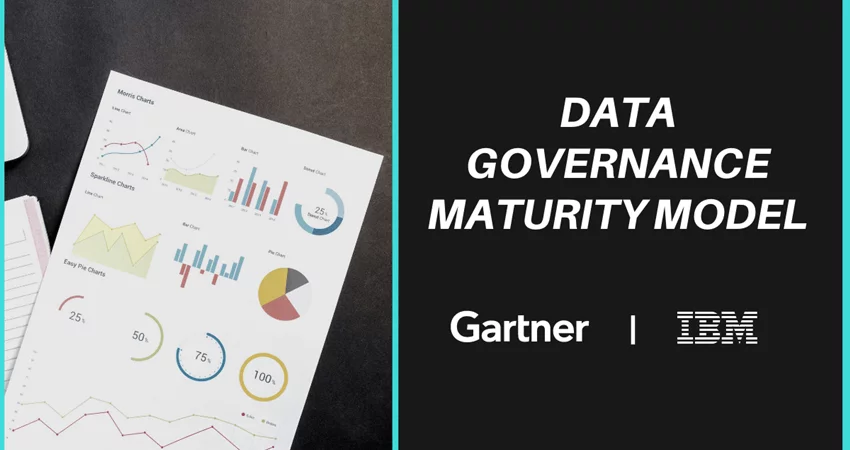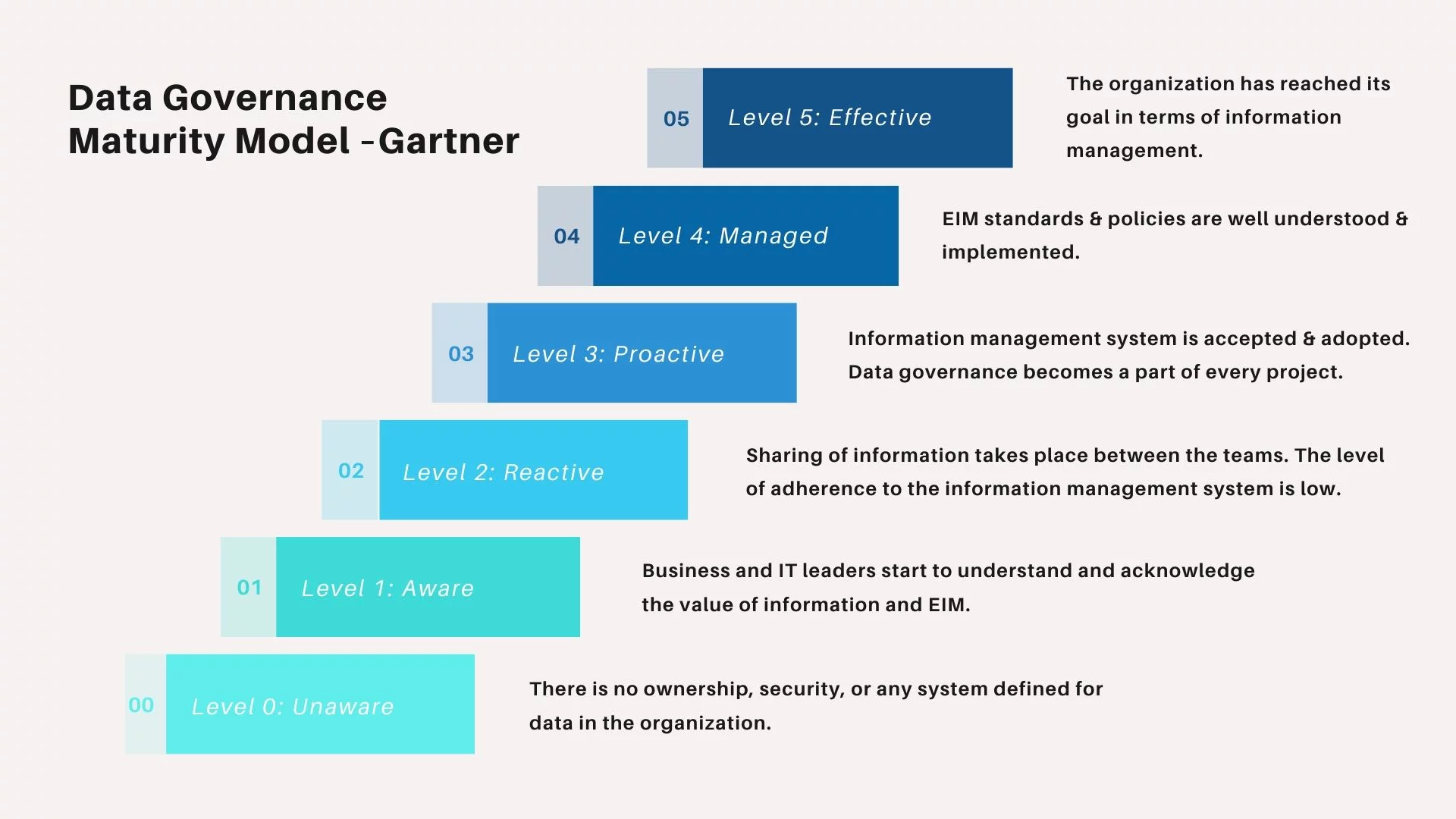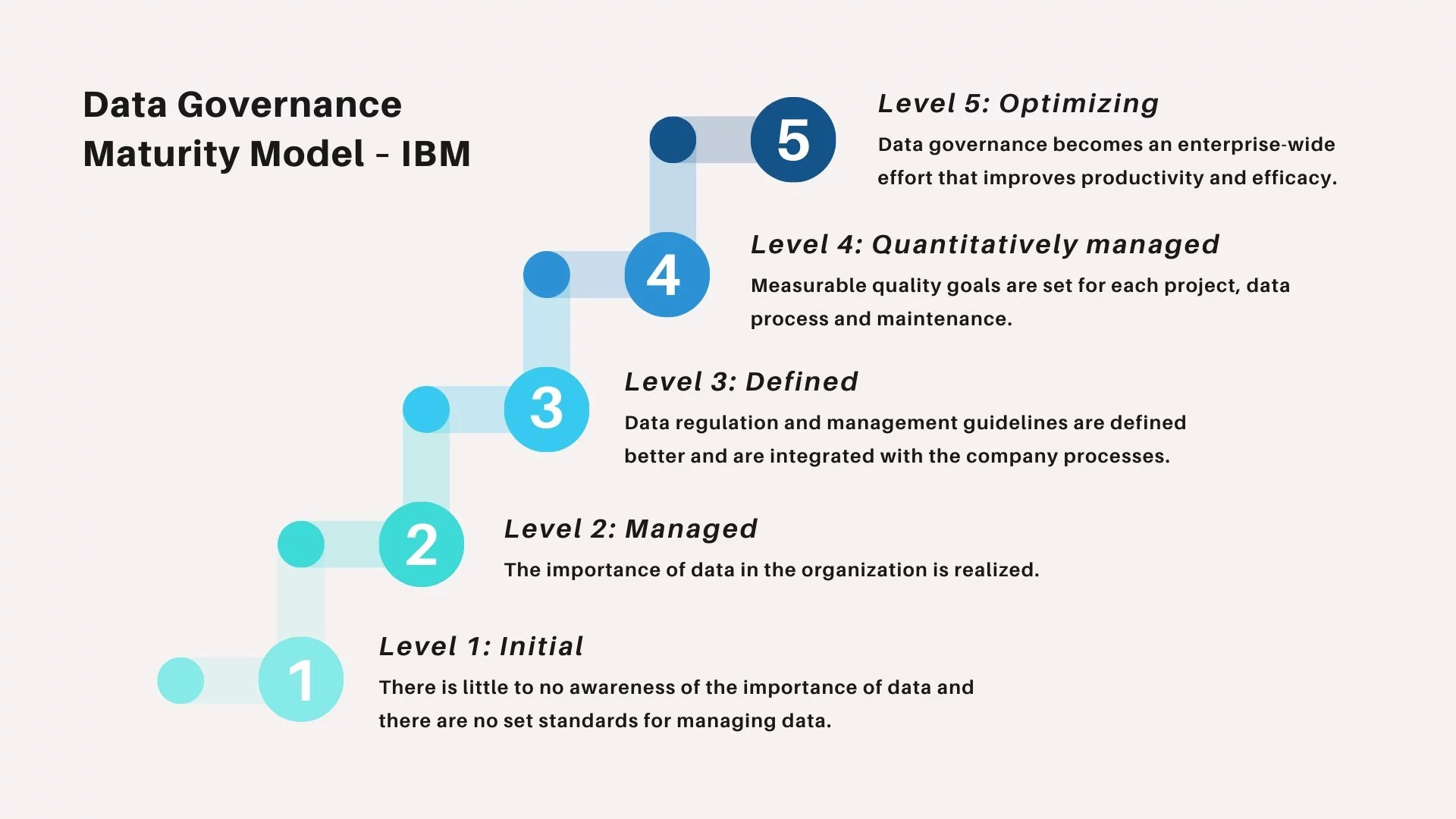Data quality cannot be ensured in a company without data governance protocols. According to the data maturity model, data’s quality rapidly deteriorates when it is unstructured and updates are made without documentation. This causes data teams a lot of trouble and also prohibits business users from exploiting firm data to innovate.
Inaccurate data sets are the result of poor data quality and a lack of data management methods. Additionally, inaccurate data can have disastrous repercussions, ranging from poor company decisions to possible data breaches and expensive compliance violations.
Organizations must implement a data governance strategy to address these problems, but for this strategy to be effective, there must be a high level of data maturity. Adopting a data governance maturity model is the best approach to accomplish this.
Data Governance Maturity and Its Models
Organizations must follow a data governance maturity model in order to reach a higher level of data governance maturity. There are many applications of this paradigm, but before we delve into the most well-known ones, let’s define the terms first.
What Exactly is Data Governance Maturity?
The degree to which an organisation has adopted and implemented data governance efforts is referred to as its level of data governance maturity. A young organisation will have a lot of disorganised data and won’t be leveraging it to spur expansion. As opposed to this, a mature organisation would understand the value of data as a crucial corporate asset and will govern and manage it accordingly.
What is a Data Governance Maturity Model?
A data governance maturity model is a tool and approach used to assess your company’s data governance initiatives and clearly convey them to the rest of the organisation. All the procedures for managing, using, and innovating with data assets are in place in a mature firm. The maturity model can help businesses with less development accomplish this goal.
A few well-known data governance maturity models exist, with examples provided by IBM, Stanford, Gartner, and Oracle among others. These models give businesses a way to discover effective data management techniques, enable user access, guarantee high-quality data, and enable everyone inside a company to gain from these advancements.
It is a good practice to assess the maturity of your organization’s system periodically. Maturity is the quantification of an organization’s ability and scope for improvement in a particular discipline.
A high level of maturity implies higher chances of improvement after the occurrence of an error or any incidence for that discipline.
These improvements could be either the quality or the use or implementation of the resources within the organization.
Data maturity models help companies understand their data capabilities, identify vulnerabilities, and know in which particular areas, employees need to be trained for improvement.
It also helps organizations compare their progress among their peers.
With maturity assessment, there is never a “one model fits all” situation. Although individual models for different organizations and vendors do exist, most follow the “Capability Maturity Model” method.
Here, we will go through two Data governance maturity models developed by two different vendors. Let’s dive right in.
First presented in 2008, this data maturity model looks at the enterprise information management system as one single unit. It has five primary goals, as follows:
- Data integration across the entire IT portfolio.
- Unification of content throughout the organization.
- Integration of master data domains.
- Smooth flow of information across the organization.
- Metadata management and semantic reconciliation.
This maturity model has a total of six stages of maturity. Each stage has its own attributes and action items. Let’s take a look at each stage in detail:
At this level, there is no awareness of any data governance activities. There is no ownership, security, or any system defined for data in the organization.
The processes for creation, gathering, and sharing of data, or information is not defined.
There is a lack of definition of common established standards for data gathering or storage for metadata management. No data models are outlined here.
Data exchange, storage, and archiving take place mainly over email. Strategic decisions are often made without enough information.
Action Items: With no awareness of any data governance policies in place, the system architects and strategy planners need to educate the business and IT leaders about the value of EIM.
This is the stage at which a lack of data governance becomes evident. Business and IT leaders start to understand and acknowledge the value of information and EIM (Enterprise Information Management).
There is a well-recognized need for a standard set of tools, processes, and models in place to establish uniformity across the organization.
Action Items: System architects and planners develop an enterprise information management strategy to suit the business needs of the organization.
The business finally understands the importance and value of information. Sharing of information takes place between the internal teams in the organization.
Although the information management system is in place, the level of adherence is low.
Action items: The management needs to promote the EIM strategies defined in the level earlier as a solution to the cross-functional data exchange issues.
At this stage, the information management system is accepted and adopted. Now, this becomes imperative to support crucial business decisions. Information owners are assigned to govern the data.
Information sharing between teams is finally considered as a pivot for enterprise-wide projects.
The policies and standards defined earlier are now employed organization-wide. Data governance becomes a part of every project in the organization.
Action items: Take EIM a step ahead and identify the opportunities at the departmental level.
Information, at this stage, is viewed as a valuable asset to the company. EIM standards and policies are well understood and implemented throughout the organization.
Information assets are categorized, and information metrics are defined. A committee is formed to solve inter-team information issues and to identify the places for the betterment of the same.
Action Items: Information management tasks need to be tracked and made sure they are in line with the EIM policies.
This is the final level wherein it is safe to say that the organization has reached its goal in terms of information management.
Information is now considered to provide the company with an added edge over its competitors. EIM strategies are linked with improved productivity and efficiency.
Action items: Define and implement controls to ensure adherence to the policies defined throughout the process. The policies should be followed irrespective of a change of leadership in the organization or a change of direction.
Data Governance Maturity Model – IBM
Introduced in 2007, this data governance model addresses a total of 11 domains mentioned below:
- Data risk management and compliance
- Value creation
- Organizational structure and awareness
- Policy
- Stewardship
- Data quality management
- Information lifecycle management
- Information security and privacy
- Data architecture
- Classification and metadata
- Audit information, logging, and reporting
This model consists of a total of five levels. Let’s take a quick look at the characteristics and the action items required for each level:
There is little to no awareness of the importance of data. There are no set standards for managing data. The existence of silos and ad-hoc data managing approaches hinder the performance of the teams.
There is almost no adherence to project deadlines. Also, there is no formal management or tracking of data.
Action Items: The system architects should study the vulnerabilities regarding the data and information flow throughout the organization.
They should come up with a plan to manage the data and present the same to the stakeholders and IT managers.
There is more realization of the importance of data and how it can benefit the organization. Data starts to be viewed as an asset in the company. There is a need for a set of data management tools and processes in place.
Action items: Data regulation and documentation guidelines are defined and set in place to be implemented.
The data regulation and management guidelines are defined as better and start integrating with the company processes. The regulation rules are refined and made less ambiguous.
There is a better use of technology to manage data. Data management practices are widely implemented throughout the organization.
Action items: Data stewardship is implemented. Risk assessment for quality of data and data management is made a part of the regular methodology.
At this stage, all the projects follow the data governance guidelines and principles. Data models are documented and made available throughout the organization.
Measurable quality goals are set for each project and data process and maintenance. The performance of the business operations is continuously measured against the set goals.
Action items: Performance measurement metrics need to be defined and set for each process.
The cost of data management is reduced, and data becomes easier to manage. Operations are more comfortable to navigate through and are streamlined.
Data governance becomes an enterprise-wide effort that improves productivity and efficacy.
Action items: ROI for any data project should be continuously assessed, analyzed, and monitored to make sure the data governance rules are followed through.
We have explained the two maturity models as examples. Now it entirely depends upon an organization’s individual needs to select any of the two. This will help the organization realize the highest level of benefits; otherwise, it’s a moot exercise.
But more importantly, enterprises need to assess themselves to not only understand where they rank among their peers in the marketplace but also to be able to plan effectively. Or else, the competition is very fierce out there and will surpass them by miles.
FAQ’s
Related Blogs:
- Understanding the Importance of Data Governance Maturity Model
- Foundation Models in AI: A new Trend and the Future



